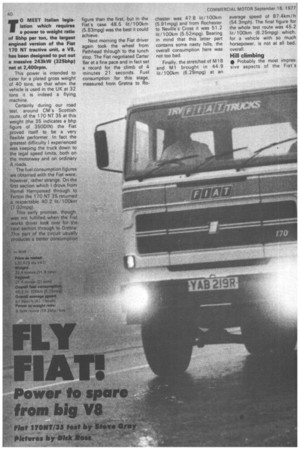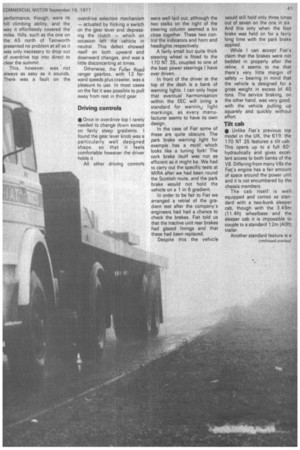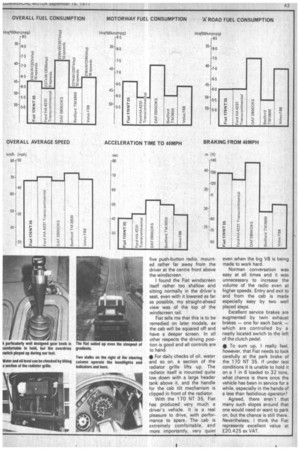T 0 MEET Italian legislation which requires a power to weight
Page 42

Page 43

Page 45

If you've noticed an error in this article please click here to report it so we can fix it.
ratio of 8bhp per ton, the largest engined version of the Fiat 170 NT tractive unit, a V8, has been designed to put out a massive 243kW (325bhp) net at 2,400rpm.
This power is intended to cater for a plated gross weight of 40 tons, so that when the vehicle is used in the UK at 32 tons it is indeed a flying machine.
Certainly during our road test, around CM's Scottish route, of the 170 NT 35 at this weight (the 35 indicates a bhp figure of 350DIN) the Fiat proved itself to be a very flexible performer. In fact the greatest difficulty I experienced was keeping the truck down to ., the legal speed limits, both on
I,
' the motorway and on ordinary A roads.
:' The fuel consumption figures , we obtained with the Fiat were, however, rather strange. On the , first section which I drove from ‘: Hemel Hempstead through to i Forton the 170 NT 35 returned i a respectable 40.2 lit/100km (7.02mpg).
,,,,. This early promise, though, was not fulfilled when the Fiat works driver took over for the next section through to Gretna. This part of the circuit usually produces a better consumption figure than the first, but in the Fiat's case 48.5 lit/100km (5.83mpg) was the best it could achieve.
Next morning the Fiat driver again took . the wheel from Pathhead thiough to the lunch stop. The Fiat negotiated Carter Bar at a fine pace and in fact set a record for the climb of 4 minutes 21 seconds. Fuel consumption for this stage, measured from Gretna to Ro
chester was 47.8 lit/100km (5.91mpg) and from Rochester to Neville's Cross it was 51.2 lit/100km (5.52mpg). Bearing in mind that this latter part contains some nasty hills, the overall consumption here was not too bad.
Finally, the stretches of M18 and M1 brought in 44.9 lit/100km (6.29mpg) at an average speed of 87.4km /h (54.3mph). The final figure for the whole test route was 45.2 lit/100km (6.25mpg) which, for a vehicle with so much horsepower, is not at all bad, overall.
Hill climbing
• Probably the most impressive aspects of the Fiat's performance, though, were its hill climbing ability, and the way it effortlessly covered the miles, Hills, such as the one on the AS north of Tamvvorth presented no problem at all as it was only necessary to drop out of overdrive top into direct to clear the summit.
This, however, was not always as easy as it sounds. There was a fault on the
16, 1977
overdrive selection mechanism — actuated by flicking a switch on the gear lever and depressing the clutch — which • on occasion left the vehicle in neutral. This defect showed itself on both upward and downward changes, and was a little disconcerting at times.
Otherwise, the Fuiler Road ranger gearbox, with 12 forward speeds plus crawler, was a pleasure to use. In most cases on the flat it was possible to pull away from rest in third gear.
Driving controls
• Once in overdrive top I rarely needed to change dovvn except on fairly steep gradients. found the gear lever knob was a particularly well designed shape, so that it feels comfortable however the driver holds it.
All other driving controls were well laid out, although the two stalks on the right of the steering column seemed a bit close together. These two control the indicators and horn and headlights respectively. A fairly small but quite thick steering wheel is fitted to the 170 NT 35, coupled to one of the best power steerings I have ever driven.
In front of the driver at the top of 'the dash is a bank of warning lights. I can only hope that eventual harmonisation within the EEC will bring a standard for warnin.j light markings, as every manufacturer seems to have its own design. In the case of Fiat some of these are quite obscure. The park brake warning light for example has a motif which looks like a tuning fork! The park brake itself was not as efficient as it might be. We had to carry out the specific tests at MIRA after we had been round the Scottish route, and the park brake would not hold the vehicle on a 1 in 6 gradient.
In order to be fair to Fiat we arranged a retrial of the gradient test after the company's engineers had had a chance to check the brakes. Fiat told us that the tractive unit rear brakes had glazed linings and that these had been replaced. Despite this the vehicle would still hold only three times out of seven on the one in six. And this only when the foot brake was held on for a fairly long time with the park brake applied. While I can accept Fiat's claim that the brakes were not bedded in properly after the reline, it seems to me that there's very little margin of safety — bearing in mind that the vehicle is designed.. for a gross weight in excess `of 40 tons. The service braking, on the other hand, was very .good, with the vehicle pulling up squarely and quickly without effort.
Tilt cab
• Unlike Fiat's previous top model in the UK, the 619, the 170 NT 35 features a tilt cab. This opens up to a full 60' hydraulically and gives excellent access to both banks of the V8. Differing from many V8s the Fia;:s engine has a fair amount of space around the power unit and it is not encumbered by the chassis members.
The cab itself, is well. equipped and' comes as standard with a two-bunk sleeper. cab, though with the 3.49m (11.4ft) wheelbase and the sleeper cab it is impossible to couple to a standard 12m (40ft) trailer.
Another standard feature is a continued overleaf five push-button radio, mounted rather far away from the driver at the centre front above the windscreen.
I found the Fiat windscreen itself rather too shallow and sitting normally in the driver's seat, even with it lowered as far as possible, my straight-ahead view was of the top of the windscreen rail.
Fiat tells me that this is to be remedied on later models, as the cab will be squared off and have a deeper screen. In all other respects the driving position is good and all controls are to hand.
• For daily checks of oil, water and so on, a section of the radiator grille lifts up. The radiator itself is mounted quite low down with a large header tank above it, and the handle for the cab tilt mechanism is clipped in front of the radiator.
With the 170 NT 35, Fiat has produced very much a driver's vehicle. It is a real pleasure to drive, with performance to spare. The cab is extremely comfortable, and more importantly, very quiet even when the big V8 is being made to work hard.
Norman conversation was easy at all times and it was unnecessary to increase the volume of the radio even at higher speeds. Entry and exit to and from the cab is made especially easy by two well placed steps.
Excellent service brakes are augmented by twin exhaust brakes — one for each bank — which are controlled by a neatly located switch to the left of the clutch pedal.
• To sum up, I really feel, however, that Fiat needs to look carefully at the park brake of the 170 NT 35. If under test conditions it is unable to hold it on a 1 in 6 loaded to 32 tons, what chance is there once the vehicle has been in service for a while, especially in the hands of a less than fastidious operator?
Agreed, there aren't that many such slopes around that one would need or want to park on, but the chance is still there. Nevertheless, I think the Fiat represents excellent value at E20,425 ex VAT.
































































































































